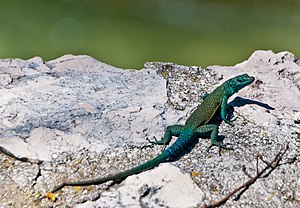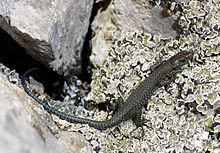Dalmatian pointed head lizard
| Dalmatian pointed head lizard | ||||||||||||
|---|---|---|---|---|---|---|---|---|---|---|---|---|

Dalmatian pointed head lizard ( Dalmatolacerta oxycephala ) |
||||||||||||
| Systematics | ||||||||||||
|
||||||||||||
| Scientific name of the genus | ||||||||||||
| Dalmatolacerta | ||||||||||||
| Arnold , Arribas & Carranza , 2007 | ||||||||||||
| Scientific name of the species | ||||||||||||
| Dalmatolacerta oxycephala | ||||||||||||
| ( Duméril & Bibron , 1839) |
The Dalmatian pointed head lizard ( Dalmatolacerta oxycephala , Syn . : Archaeolacerta oxycephala , Lacerta oxycephala ) is the only species of its genus . It is native to Dalmatia .
features
The Dalmatian pointed head lizard grows to 19 to 20 centimeters long, with its head and trunk measuring only 6.5 centimeters. It is a typical dainty and strongly flattened lizard with a very flat, pointed head. Their backs are black-brown or brownish-gray and have light, net-like polka dots. On islands or in mountains it is almost black. Their belly is bright blue or bluish gray. Their tail is ringed blue and black. The pairs of scales on the underside of the tail are thinner on the outside than in the middle.
Habitat / distribution
The lizard occurs in the Adriatic coastal area from southern Croatia and Bosnia-Herzegovina to Lake Skadar in Montenegro , as well as on the offshore islands. Their habitat extends from the Adriatic coast up to a maximum height of 1500 meters above sea level . In the Neretva valley , its range reaches 80 km, the maximum distance from the coast. It lives exclusively in stony habitats, e.g. B. rock walls, scree and stone walls, often together with the wall lizard and the ruin lizard . The animals are not very sensitive to cold and only hibernate for a short time from December to February. There is a risk of confusion with the Mosor mountain lizard . However, this has six pairs of mandibular shields and no curly tail.
nutrition
The lizard feeds on insects , spiders, woodlice, other arthropods and worms.
Reproduction
During the breeding season from March to April they live in pairs and the partners defend a common territory. The female lays two to four very elongated, yellow-white eggs in June, from which the small lizards hatch after about six to seven weeks. The young lizards have a more conspicuously colored tail.
literature
- Günter Diesener, Josef Reichholf : amphibians and reptiles. (137 European species) (= Steinbach's natural guide. ). Mosaik-Verlag, Munich 1996, ISBN 3-576-10697-9 .
- Manfred Rogner : Lizards. Keeping, care and breeding in the terrarium. Volume 2: Monitor lizards, skinks and other lizards as well as bridge lizards and crocodiles. Ulmer, Stuttgart 1994, ISBN 3-8001-7253-4 .
Web links
- Distribution map in the Reptile Atlas of the European Herpetological Association
- photos
- Photos of the Dalmatian Pointed Head Lizard on www.herp.it
- Dalmatolacerta oxycephala in The Reptile Database
- Dalmatolacerta oxycephala inthe IUCN 2013 Red List of Threatened Species . Posted by: Jelka Crnobrnja Isailovic, Rastko Ajtic, Milan Vogrin, 2008. Accessed February 1, 2014.
